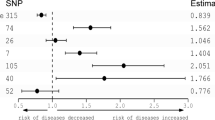Abstract
Schizophrenia patients commonly have sleep disturbances. In this study, we investigated whether single nucleotide polymorphisms (SNPs) in the promoter region of the melatonin receptor genes (MTNR1A and MTNR1B) were associated with schizophrenia and with sleep problems such as insomnia and hypersomnia in schizophrenia patients. We genotyped two promoter SNPs [rs2119882 (−184T/C) of MTNR1A and rs4753426 (−1193C/T) of MTNR1B] using direct sequencing in 289 schizophrenia patients and 505 control subjects. We found that rs2119882 of MTNR1A was associated with schizophrenia in recessive model [CC vs. TT/TC, p = 0.013, odds ratio (OR) = 1.69, 95% confidence interval (CI) = 1.12–2.55]. Interestingly, in an analysis of clinical phenotypes, we found that rs2119882 of MTNR1A was also associated with insomnia symptoms of schizophrenia (recessive model, p = 0.010, OR = 2.24, 95% CI = 1.21–4.14), but not with hypersomnia symptoms as determined using the Operational Criteria checklist. However, rs4753426 of MTNR1B was not associated with either schizophrenia or clinical phenotypes. Our results suggest that MTNR1A may be a susceptibility gene for schizophrenia and may be associated with insomnia symptoms exhibited in schizophrenia patients.
Similar content being viewed by others
References
Afonso P, Brissos S, Figueira ML, Paiva T (2010) Discrepant nocturnal melatonin levels in monozygotic twins discordant for schizophrenia and its impact on sleep. Schizophr Res 120:227–228
American Psychiatric Association (1994) Diagnostic and statistical manual of mental disorders, 4th edn. American Psychiatric Association, Washington, DC
Andreasen NC (1982) Negative symptoms in schizophrenia. Definition and reliability. Arch Gen Psychiatry 39:784–788
Bernstein HG, Heinemann A, Krell D et al (2005) Hypothalamic nitric oxide synthase in affective disorder: focus on the suprachiasmatic nucleus. Cell Mol Biol 51:279–284
Bersani G, Mameli M, Garavini A, Pancheri P, Nordio M (2003) Reduction of night/day difference in melatonin blood levels as a possible disease-related index in schizophrenia. Neuro Endocrinol Lett 24:181–184
Dikeos DG, Wickham H, McDonald C et al (2006) Distribution of symptom dimensions across Kraepelinian divisions. Br J Psychiatry 189:346–353
Haug HJ, Wirz-Justice A, Rossler W (2000) Actigraphy to measure day structure as a therapeutic variable in the treatment of schizophrenic patients. Acta Psychiatr Scand Suppl 102:91–95
Ibuka N, Inouye SI, Kawamura H (1977) Analysis of sleep–wakefulness rhythms in male rats after suprachiasmatic nucleus lesions and ocular enucleation. Brain Res 122:33–47
McGuffin P, Farmer A, Harvey I (1991) A polydiagnostic application of operational criteria in studies of psychotic illness. Development and reliability of the OPCRIT system. Arch Gen Psychiatry 48:764–770
Migaud M, Daveau A, Malpaux B (2005) MTNR1A melatonin receptors in the ovine premammillary hypothalamus: day–night variation in the expression of the transcripts. Biol Reprod 72:393–398
Monteleone P, Natale M, La Rocca A, Maj M (1997) Decreased nocturnal secretion of melatonin in drug-free schizophrenias: no change after subchronic treatment with antipsychotics. Neuropsychobiology 36:159–163
Monti JM, Monti D (2005) Sleep disturbance in schizophrenia. Int Rev Psychiatry 17:247–253
Poyurovsky M, Nave R, Epstein R et al (2000) Actigraphic monitoring (actigraphy) of circadian locomotor activity in schizophrenic patients with acute neuroleptic-induced akathisia. Eur Neuropsychopharmacol 10:171–176
Reppert SM, Weaver DR, Ebisawa T (1994) Cloning and characterization of a mammalian melatonin receptor that mediates reproductive and circadian responses. Neuron 13:1177–1185
Reppert SM, Godson C, Mahle CD, Weaver DR, Slaugenhaupt SA, Gusella JF (1995) Molecular characterization of a second melatonin receptor expressed in human retina and brain: the Mel1b melatonin receptor. Proc Natl Acad Sci USA 92:8734–8738
Robinson S, Rosca P, Durst R et al (1991) Serum melatonin levels in schizophrenia and schizoaffective hospitalized patients. Acta Psychiatr Scand 84:221–224
Strother WN, Norman AB, Lehman MN (1998) D1-dopamine receptor binding and tyrosine hydroxylase-immunoreactivity in the fetal and neonatal hamster suprachiasmatic nucleus. Brain Res Dev Brain Res 106:137–144
Tandon R, Shipley JE, Taylor S et al (1992) Electroencephalographic sleep abnormalities in schizophrenia. Relationship to positive/negative symptoms and prior neuroleptic treatment. Arch Gen Psychiatry 49:185–194
Trbovic SM (2010) Schizophrenia as a possible dysfunction of the suprachiasmatic nucleus. Med Hypotheses 74:127–131
Viswanathan N, Weaver DR, Reppert SM, Davis FC (1994) Entrainment of the fetal hamster circadian pacemaker by prenatal injections of the dopamine agonist SKF 38393. J Neurosci 14:5393–5398
Wulff K, Joyce E, Middleton B, Dijk DJ, Foster RG (2006) The suitability of actigraphy, diary data, and urinary melatonin profiles for quantitative assessment of sleep disturbances in schizophrenia: a case report. Chronobiol Int 23:485–495
Zarcone VP, Benson KL Jr, Berger PA (1987) Abnormal rapid eye movement latencies in schizophrenia. Arch Gen Psychiatry 44:45–48
Acknowledgments
This research was supported by the Kyung Hee University Research Fund in 2008 (KHU-20081561).
Author information
Authors and Affiliations
Corresponding author
Additional information
H. J. Park and J. K. Park contributed equally to this work.
Rights and permissions
About this article
Cite this article
Park, H.J., Park, J.K., Kim, S.K. et al. Association of Polymorphism in the Promoter of the Melatonin Receptor 1A Gene with Schizophrenia and with Insomnia Symptoms in Schizophrenia Patients. J Mol Neurosci 45, 304–308 (2011). https://doi.org/10.1007/s12031-011-9522-6
Received:
Accepted:
Published:
Issue Date:
DOI: https://doi.org/10.1007/s12031-011-9522-6




